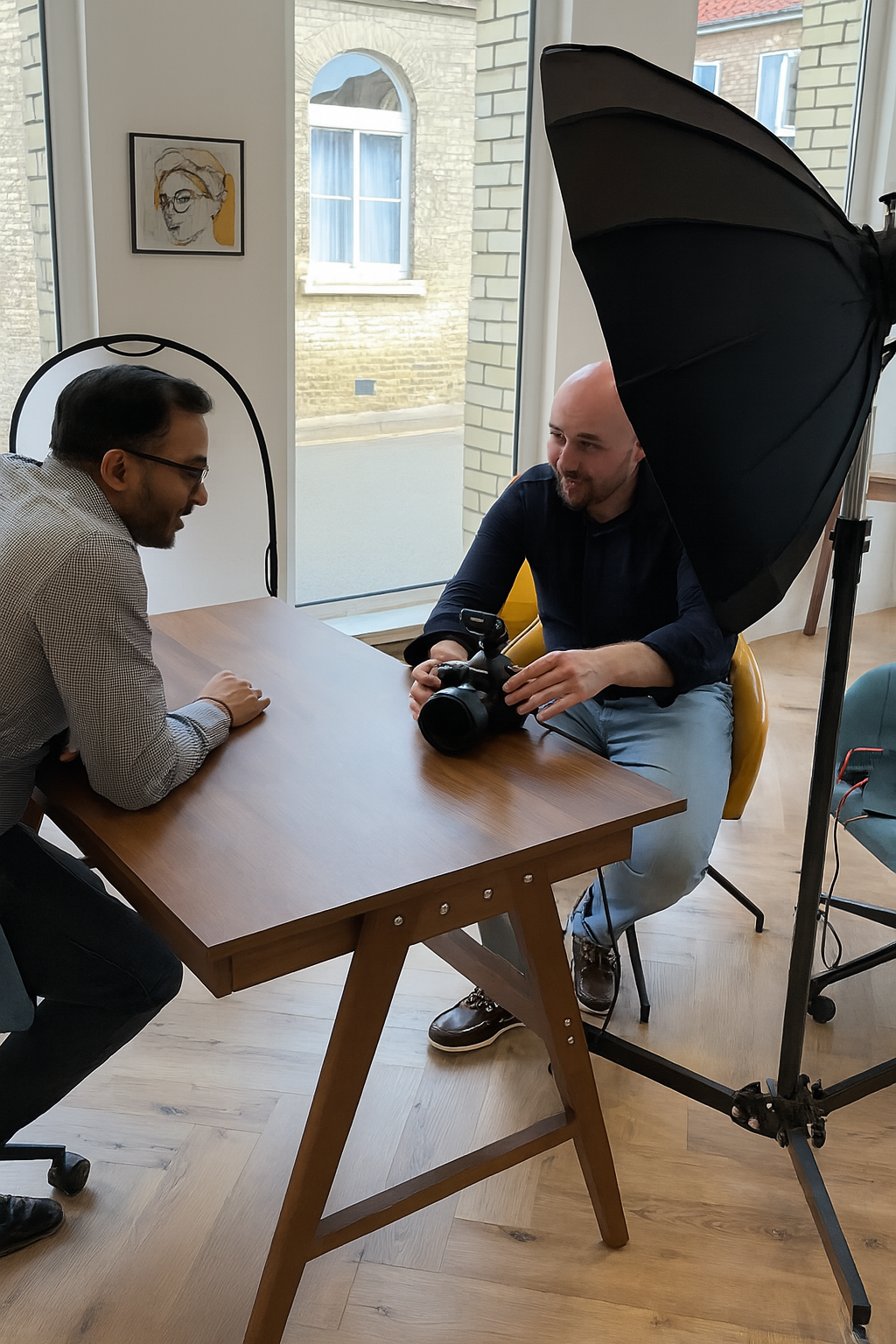Beyond the Feed: How East Anglian Businesses Can Master Social Media in an Era of Reluctant Reels, Relentless Algorithms, and Real Opportunity

Introduction: Norfolk Caution Meets Social Media Change
In Norfolk, as in much of East Anglia, business is grounded in trust, quiet confidence, and relationships that last. There’s an old-fashioned pride in doing things properly and letting your work speak for itself. So when talk turns to social media “innovations” like LinkedIn Reels (short-form videos), Stories, or TikTok trends, many local business owners and directors respond with a wry smile and a healthy dose of scepticism. “That’s not really what we’re here for, is it? We’ve always relied on recommendations and reputation. Why would we suddenly need to film ourselves or jump on some viral craze?”
It’s a fair question and an attitude that’s helped Norfolk businesses steer clear of plenty of fads. But over the last few years, the very platforms that once seemed separate from serious business have changed. Social media is no longer just for the young, the loud, or the tech-savvy. It is now, quite simply, where your future customers are searching, researching, and deciding who to trust.
The irony is that this digital shift does not erase what makes East Anglian firms special. If anything, it puts more value on authenticity, community, and expertise, precisely the things local businesses have in spades. The challenge is to show it, not just say it, in the formats and places that matter most today.
From Followers to Interest: How Algorithms Now Decide
It wasn’t so long ago that the size of your following seemed to matter above all else. Every business was urged to collect “likes,” “followers,” and page connections, the idea being that the bigger your network, the greater your reach. But today, things are very different. The main social platforms now use what’s called the “interest graph” (Hootsuite: How Social Media Algorithms Work). This means that the content people actually see in their feeds is decided less by who they follow and more by what they interact with, search for, and spend time watching.
For businesses across Norwich, Ipswich, and the market towns of Norfolk and Suffolk, this is both a challenge and an opportunity. The challenge is that you can no longer rely on just broadcasting to your loyal audience. The opportunity is that your most relevant, engaging posts can now be shown to completely new prospects, locally and even nationally, provided you hit the right topics and formats. It is, in effect, a levelling of the playing field, if you know how to use it.
The Rise of Video and Stories: Why the Platforms Changed
The reason many in Norfolk feel that LinkedIn, Instagram, and other platforms “aren’t what they used to be” is simple: the technology itself has changed, and with it, people’s expectations. This started in earnest when Snapchat introduced Stories, a new format that allowed users to share images and videos that disappeared after twenty-four hours. Soon after, Instagram Stories launched and became a runaway success, followed by Facebook, WhatsApp, and even LinkedIn’s short-lived Stories feature.
TikTok’s meteoric rise, built around short-form, mobile-first video, has only reinforced this trend (TikTok Newsroom). People everywhere became used to fleeting, behind-the-scenes content; candid, real, and often more interesting than the usual corporate posts. Instagram Reels and LinkedIn native video now regularly outperform text and image-only updates.
For East Anglian businesses, this isn’t just a question of following fads. It’s a practical shift: you are now more likely to be discovered and remembered if you show up in these new formats, sharing useful advice, showcasing your people, or even offering a glimpse of daily life in your business.
It might mean a Norwich bakery showing today’s loaves on Instagram Stories, a Suffolk contractor offering a sixty-second project tour, or a local law firm answering the week’s most common client question via LinkedIn video. The content doesn’t have to be slick or viral, just visible, real, and relevant.
Objections and Reluctance: “That’s Not What I’m Here For”
If you mention Reels on LinkedIn or TikTok videos in a Norfolk boardroom, you’ll hear honest objections. “I don’t want my professional network turning into a circus. We’re not here to dance or do silly skits.” The sentiment is understandable, and it’s shared by many who feel that new social formats are a poor fit for serious businesses or local communities.
But here’s the crucial point: the new technology does not require you to become something you are not. Instead, it provides an opportunity to communicate your professionalism, expertise, and values in formats people are now naturally watching and trusting. You can still be true to your brand and roots, only now, your message can travel further and faster.
For a thoughtful perspective on adapting your approach, see LinkedIn’s official marketing blog.
The most successful businesses in Norfolk and Suffolk are not those who abandon their identity, but those who adapt their story to the platforms people are actually using. You do not have to “go viral.” You do have to be findable, approachable, and clear about what makes you valuable to your community and clients.
Trends as Tools, Not Traps
There’s a fine line between using a trend well and getting lost in the noise. For every national campaign or meme, there are local businesses who try to join in and feel it falls flat, or worse, risks their credibility. The answer is not to ignore trends altogether, but to be selective. When a trend allows you to share your expertise, join a timely conversation, or highlight a unique aspect of your business, it is worth considering. But if it feels off-brand or forced, there is no harm in sitting it out.
The real advantage of trends now comes from the platforms’ algorithms. Because they surface content that’s both timely and popular, a business that uses the right format at the right moment can reach audiences far outside its usual circle. Sprout Social’s 2024 Social Media Trends report provides up-to-date insight on when and how to engage.
During the annual Norwich Food and Drink Festival, for example, a local restaurant using Stories and relevant hashtags saw their audience double for that week, and their booking enquiries rose accordingly. The lesson: trends should amplify your best qualities, not dilute them.
Mapping Your Audience: Getting Practical with Search and Social
A good strategy starts with knowing your audience, not just in theory, but in practice. Begin with keyword research using tools like Google Keyword Planner, Answer the Public, and Ubersuggest. Type in phrases like “Norfolk builder,” “accountant in Norwich,” or “eco-friendly sheds Suffolk.” Look at the suggested questions and related searches, as these show what real people want to know, when, and where.
Review your own Google Analytics to see which pages and blog posts get the most visits. Check Facebook Insights, Instagram Insights, and LinkedIn Analytics for patterns in engagement.
Look at local competitor sites and leading directories, such as Norfolk Chambers of Commerce, to spot gaps in coverage or questions left unanswered.
Do not stop at search terms. Review your existing web analytics to see which pages bring the most traffic and which social posts get the highest engagement. Are there recurring questions from your clients that could be answered in a post or short explainer video? Are people finding you with branded or unbranded searches? This kind of insight turns guesswork into precision targeting, allowing you to craft content that your local audience is actively seeking out.
Mapping your audience also means understanding their social behaviour. If most of your ideal clients are active in local Facebook groups or regularly sharing content on LinkedIn, prioritise those channels and adjust your tone accordingly. Track which competitor posts get genuine discussion or shares, and use that intelligence to fill content gaps or offer a more informed perspective. Over time, your strategy becomes less about what you “think” people want and more about what the data proves is working.
The Temple Brown Discovery Process: Turning Local Insight Into Strategy
At Temple Brown, everything begins with discovery; an honest conversation about your objectives, strengths, and where you want to grow. We start by asking: Who are your most profitable customers? Where do you see the biggest opportunities for growth in Norfolk, Suffolk, or across East Anglia? What makes your business different…not in a generic way, but in the specific stories, values, and results you’ve achieved?
Use tools like SEMrush Social Media Toolkit, Google Trends, and Moz Local for research and competitor audits.
With all this insight, we design a practical, channel-by-channel plan. For some, the focus will be on building authority with LinkedIn thought leadership and video Q&As. For others, it is about sharing real customer journeys on Facebook, or using Instagram Stories to bring your products and team to life. Every plan includes a careful mix of content types; video, photos, long-form articles, quick updates, matched to what performs best on each platform.
A key part of the Temple Brown Discovery Process is the content calendar. Instead of scrambling for ideas, you have a steady drumbeat of posts tied to local events, seasonal moments, business milestones, and industry news. This calendar is not fixed in stone. It evolves as your analytics show what works and where attention is shifting, ensuring that you are always relevant, never repetitive.
Crucially, the process does not end with publishing. Each month, we review performance using the best analytics from Google, LinkedIn, and Facebook. We track reach, engagement, clicks, enquiries, and even which posts drive real conversations and sales. If a format is underperforming, we adjust. If a certain type of story resonates, we double down. This is not guesswork; it is a living strategy, based on evidence and always focused on commercial results.
For further advice on building a content calendar, see Hootsuite’s Social Media Calendar Guide.
Content That Counts: Creating for People and Platforms
Content is not just about filling a feed. It is the voice, face, and personality of your business, often the first impression for new customers. In East Anglia, the best content combines local relevance with formats that people actually engage with.
Start with video wherever possible. For tips on making professional but approachable social videos, see Social Media Examiner’s LinkedIn Video Guide.
Use your local keywords in captions and hashtags, for example, “Norwich digital marketing tips” or “Suffolk business support.” Explainer articles and FAQs about common local searches, like “How to choose a Norfolk accountant” or “Planning a garden office in Suffolk” can boost SEO and make your business findable year-round.
Recurring features such as “Friday FAQ” or “East Anglia Business Spotlight” give structure to your calendar. For inspiration, review Content Marketing Institute’s guide to social content formats.
Build in recurring features such as “Friday FAQ,” “Meet the Team Monday,” or “East Anglia Business Spotlight.” These give structure to your content calendar and give your audience something to look forward to each week.
Measurement, Community, and Earning Trust
A strategy means nothing unless you know it is working. Use analytics tools on each social platform to track what’s working. Post reach, engagement rates, video watch times, clicks to your website, and direct enquiries or leads. Look for patterns. Are your LinkedIn videos about “Norfolk business advice” getting shared outside your first-degree connections? Is your Instagram Story bringing in more website visits or calls during a local event?
Set practical goals for each platform. It might be a monthly increase in post engagement, more website traffic from Facebook, or more reviews and user-generated content tagged with your location. Revisit your analytics at least once a month, update your list of winning topics and keywords, and adjust your content mix accordingly.
Building community is about more than broadcasting. Reply to comments, thank people for sharing, and get involved in local online groups or forums. Share and celebrate other businesses’ achievements, and ask your audience for input or stories of their own. If you run a special event or take part in a community project, show it, both for your existing network and for new people searching “Norwich charity partners” or “Suffolk community events.”
Encourage your customers to share photos, reviews, or stories using a branded hashtag or by tagging your business, and showcase these contributions in your own feed, with their permission. This multiplies your reach and gives social proof that you’re trusted and active in the region.
For step-by-step measurement, Google’s guide to Social Media Analytics is invaluable. For best practice on reputation management, Moz’s Reputation Management Guide is a trusted resource.
Building community means replying to comments, thanking people for sharing, and engaging with local forums such as Love Norwich Food or Visit East of England for partnership and audience-building opportunities.
Conclusion: The Discovery Process; Adapting With Purpose, Not Hype
Social media is not about becoming someone you are not, nor is it about chasing every shiny new feature just for the sake of it. The most successful businesses in Norfolk, Suffolk, and across East Anglia are those who respect their traditions, know what their customers value, and are willing to adapt with purpose. The technology has changed. Whether it is LinkedIn Reels, Instagram Stories, or TikTok’s short-form videos, but the principles of building trust, showing expertise, and being present in the right moments remain constant.
At Temple Brown, we recognise that many businesses across our region approach these changes with a healthy degree of caution. There is wisdom in that instinct. Our Discovery Process is designed to ensure you do not lose sight of what makes your brand distinctive, but instead find the right blend of old and new to move your business forward. We start with what matters to you. Your reputation, your audience, your goals, then build a practical, evidence-led social media strategy that reflects the evolving landscape and the real opportunities it brings.
By combining your local strengths with our structured, insight-driven approach, you can step confidently into modern social media. You will be able to participate in new formats and trends when they make sense for your business, speak to your audience in ways they are already listening for, and measure your progress at every step. This is not about being the loudest, the trendiest, or the most experimental; it is about being visible, credible, and remembered, so when customers are ready to choose, your business is the one they trust.
If you are ready to take the next step, or simply want a conversation about how to adapt without losing your sense of self, Temple Brown is here to help. Our Discovery Process will guide you every step of the way, turning East Anglian strengths into digital opportunities that last.
For further learning, Google’s SEO Starter Guide and Ahrefs’ Social Media Strategy Framework offer trusted reference points.
Ready to see how we can help? Get in touch today
Featured Project
Check out our insights
Check out all of our new articles!







